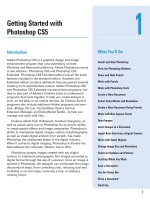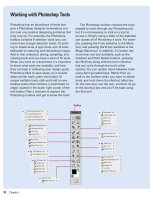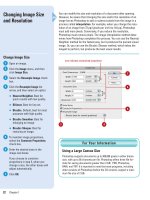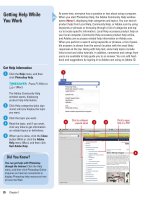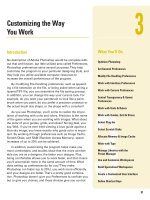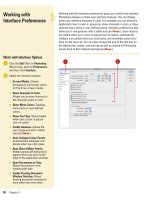Photoshop cs5 by steve Johnson part 7 ppt
Bạn đang xem bản rút gọn của tài liệu. Xem và tải ngay bản đầy đủ của tài liệu tại đây (760.89 KB, 6 trang )
ptg
40 Chapter 2
Since easily changing the magnification of an image is fundamental to
an optimal workflow, Photoshop gives you several ways to accomplish
zooming. One way to zoom is using the options on the Options bar. To
access the Zoom tool options, you must have the Zoom tool selected.
Photoshop gives you two handy zoom preset values. To automatically
zoom the document to 100%, double-click the Zoom tool. To automati-
cally fit the image into the Photoshop workspace, double-click the
Hand tool.
Increasing or
Decreasing
Magnification
Increase the Magnification
of an Image
Click the Zoom In or Zoom Out
buttons on the Options bar, and
then click in the document window
to increase or decrease the zoom.
Select the Resize Windows To Fit
check box on the Options bar to
resize the active document to fit
the zoomed window.
Select the Zoom All Windows
check box to zoom all open
document windows to the same
magnification.
Select the Scrubby Zoom check
box to zoom with a scrubby slider
(New!). If grayed out, enable
OpenGL Drawing in Performance
Preferences.
Click Actual Pixels, Fit Screen, Fill
Screen, or Print Size on the
Options bar to quickly zoom the
screen to a preset size.
TIMESAVER
It's possible to
change the zoom of a document
without ever leaving the keyboard.
Hold the Ctrl (Win) or
A
(Mac)
key, and then press the plus "+",
or minus "-" keys. The plus key
increases the zoom size, and the
minus key decreases the zoom
size.
5
4
3
2
1
1
2
View using the
Actual Pixels button
View using
the Fit On
Screen
button
View
using the
Print Size
button
3
5
4
From the Library of Wow! eBook
ptg
Chapter 2 Understanding Navigation and Measurement Systems 41
One of those little used, but handy, tools is Photoshop's Hand tool. The
Hand tool (so named because it resembles an open hand) lets you
quickly move the active image within the document window without
ever using the scroll bars. For example, you've zoomed the image
beyond the size that fits within the document window and you need to
change the visible portion of the document. It's a simple operation, but
a handy one to know. If you have OpenGL on your computer, you can
use the Rotate View tool to tilt the canvas for a more comfortable work-
ing angle, which is helpful when working with drawing tablets.
Moving Images in
the Document
Window
Move an Image in the
Document Window
Select the Hand or Rotate View
tool on the toolbox.
Drag in the active document to
move or rotate the image.
When you rotate the image to a
different canvas angle, a compass
appears to indicate north in the
image regardless of the current
canvas angle.
◆ To ro tate a specific angle, enter
a value in the Rotation Angle
field.
To re store the image back to the
normal canvas angle from a
rotation, click Reset View.
3
2
1
Did You Know?
You can quickly access the Hand tool
whenever you need it.
Hold down the
Spacebar to temporarily change to the
Hand tool. Drag in the active document
to the desired position, and then
release the Spacebar. You're instantly
returned to the last-used tool. It’s
important to note that you cannot use
the Spacebar to access the Hand tool
if you are currently using the Type tool.
1
2
2
Rotate View tool
Hand tool
From the Library of Wow! eBook
ptg
42 Chapter 2
When you open multiple documents, you can use the Window menu or
tabs at the top of the Document window to switch between them. You
can click a tab name to switch and activate the document. By default,
tabs are displayed in the order in which you open or create documents.
However, you can change the order. When you want to move or copy
information between documents, it’s easier to display several
Document windows at the same time and move them around. The
Arrange Documents menu makes it easy to display open document
windows on the screen for better views.
Working with Multiple
Documents
Work with Multiple Documents
Open more than one document.
Click a tab name to switch to the
document.
TIMESAVER
Press Ctrl+Tab or
Ctrl+Shift+Tab to cycle to a tab.
◆ You can also click the Window
menu, and then click a
document name at the bottom
of the menu.
Click the Arrange Documents menu
on the Application bar, and then
select an arrangement button icon:
◆ Consolidate All. Displays the
active document.
◆ Tile All In Grid. Displays all
open documents in a grid.
◆ Tile All Vertically. Displays all
open documents vertically.
◆ Tile All Horizontally. Displays
all open documents horizontally.
◆ 2-Up, 3-Up, 4-Up, 5-Up, or 6-Up.
Displays the number of
documents in a pattern.
To mo ve a document window
around, do any of the following:
◆ To re arrange the order of
documents, drag a window’s’
tab to a new location.
◆ To do ck or undock a document
window, drag the window’s tab
out of the group or into the
group.
4
3
2
1
2 4
1
3
Results of 3-Up document arrangement
From the Library of Wow! eBook
ptg
Chapter 2 Understanding Navigation and Measurement Systems 43
There are times when you're working on an image in Photoshop, and
you need to see two separate views of the image. For example, you're
working on retouching a photo and you need a zoomed-in view to do
fine detail work. At the same time, you want to see a normal view to get
an idea of how the retouching is affecting the full-sized image. Being
able to view one image at two different magnifications is a valuable
tool. You can also use the Arrange Documents menu to rearrange open
document windows on the screen for better views.
Working with One
Image in Multiple
Windows
Create Two Views of One Image
Open a document.
Click the Arrange Documents
menu, and then click New
Window.
A copy of the active document is
created in a new window.
If you want to arrange multiple
documents, click the Arrange
Document menu, and then select
an arrangement button icon (see
the
For Your Information
for more
details).
Select the Zoom tool on the
toolbox, and then increase the
zoom of the new document to the
desired level.
Select an editing or painting tool,
and then begin work on the new
image in the zoomed window.
The effects of your work instantly
display in the normal image
window.
When you’re done with the new
window, click the Close button.
6
5
4
3
2
1
164
New window with
zoomed document
Did You Know?
You can prevent the zoomed window
from expanding.
With the Zoom tool
selected, move into the Options bar
and deselect Resize Windows To Fit.
Arranging and Matching Multiple Windows
The Arrange submenu from the Window menu and the Arrange
Documents menu provides options to help you work with multiple win-
dows. You can use the Cascade, Tile, Float in Window, Float All in
Windows, and Consolidate All to Tabs commands to display windows
across the Photoshop workspace. The Match Zoom, Match Location,
Match Rotation and Match All commands allow you to match the zoom
and/or location in multiple windows. For example, open multiple
images, click the Arrange Documents menu, and then click Match All.
Select the Zoom tool or Hand tool, select one of the images, hold down
the Shift key, and click in or drag an area with the tool. The other
images are zoomed to the same percentage and location you chose for
the first image.
For Your Information
3
From the Library of Wow! eBook
ptg
44 Chapter 2
Photoshop has a lot of tricks up its electronic sleeves, and one of the
handiest is the ability to move layers between open documents. For
example, you have an image of a landscape and sky, but you don't like
the sky, so you erase it. You then open another document with a sky
that suits the design of your document. It's a simple matter to move the
layer containing the preferred sky into any other open document.
Moving Layers
Between Two Open
Documents
Move Layers Between
Documents
Open two or more documents.
Click on the document containing
the layer you want to move to
make it the active document.
Select the Move tool on the
toolbox.
Drag the layer you want to move
from the open document window
into the second document.
IMPORTANT
If the document
you're moving a layer into contains
more than one layer, Photoshop
places the layer you're moving
directly above the active layer in
the second document. If the layer
is in the wrong stacking order,
drag it up and down in the Layers
panel until it's correctly
positioned.
4
3
2
1
4
3
Did You Know?
You can also drag a layer thumbnail
onto a document.
Drag the layer
thumbnail from the Layers panel into
the document window of the second
document.
Removing the Excess
If you're dragging a layer from a document that contains more pixels
than the document you're moving it into, the areas of the image out-
side the viewable area of the document are still there, taking up file
space. To delete them, first position the image exactly where you
want, click the Select menu, and then click Select All. Select the
Image menu, and then click Crop. That's it. All the image information
outside the viewable window is removed.
From the Experts Corner
2
From the Library of Wow! eBook
ptg
Chapter 2 Understanding Navigation and Measurement Systems 45
Creating Notes
Click the Close button.
Create a Note
Select the Note tool on the
toolbox.
Click on the active document or
the canvas to create a blank note.
Enter the text for your note.
TIMESAVER
Click the note
icon to select it and click again to
deselect the note. You can also
right-click a note icon to access a
shortcut menu with note
commands.
Click the Next or Previous button
to scroll through multiple notes
one at a time.
5
4
3
2
1
Notes can be found everywhere—you see them stuck to the side of
refrigerators, bulletin boards, and even covering your computer moni-
tor. Notes remind you of important tasks and events. When you work in
Photoshop, the ability to save notes can help you remember an impor-
tant part of the design, or they can instruct another designer in the
how's and why's of your document. For example, you can attach spe-
cific instructions in the form of Photoshop Notes to your service bureau
on the printing of a document to obtain the best output. Text input is
done through the Notes panel. When you place a note, it
doesn’t become part of the image, but it is saved with the image.
Did You Know?
You can change the Author and the
default color of a Note.
Select a note,
and then use the Author and color
options on the Options bar to create a
personalized note. You can show and
hide note icons by choosing
View/Extras/Notes.
Action Keystrokes
Deselect a note Click on the selected note to deselect.
Reopen a note Click on the Note icon and use the Notes
panel to edit the text, if desired.
Delete a note Choose the specific note from the Notes panel,
and then press Delete or select the Note and
drag it to the Trash can in the Notes panel.
Working with Notes
1
4
3
5
2
From the Library of Wow! eBook
